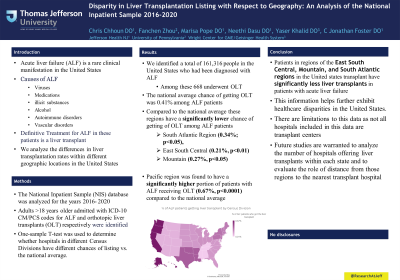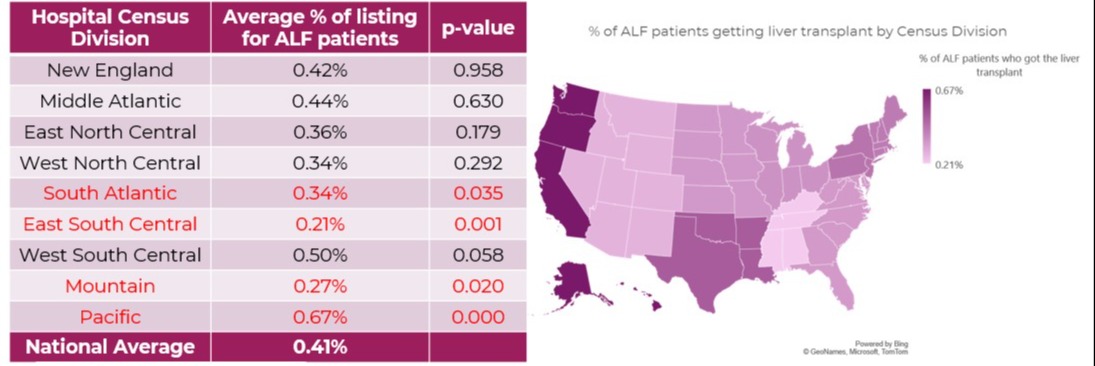Tuesday Poster Session
Category: Liver
P3784 - Disparity in Liver Transplantation Listing with Respect to Geography : An Analysis of the National Inpatient Sample 2016-2020
Tuesday, October 24, 2023
10:30 AM - 4:00 PM PT
Location: Exhibit Hall

Has Audio

Christopher Chhoun, DO
Jefferson Health
Cherry Hill, New Jersey
Presenting Author(s)
Christopher Chhoun, DO1, Fanchen Zhou, MBA2, Nielsen Gabriel, DO3, Marisa Pope, DO4, Neethi Dasu, DO5, Yaser Khalid, DO6, Jonathan Foster, DO1, Kwan Lau, MD3
1Jefferson Health, Cherry Hill, NJ; 2University of Pennsylvania, Philadelphia, PA; 3Temple University Hospital, Philadelphia, PA; 4Jefferson Health, Stratford, NJ; 5Jefferson Health, New Jersey, NJ; 6Wright Center for GME/Geisinger Health System, Scranton, PA
Introduction: Acute liver failure (ALF) is a rare clinical manifestation in the United States. The multiple etiologies that cause acute liver failure include viruses, medications, illicit substances, alcohol, autoimmune disorders, or vascular disorders. These patients will experience coagulopathies, encephalopathy, and jaundice. The definitive treatment for these patients is urgent liver transplantation. In our study, we analyze the differences in liver transplantation within different geographic locations in the United States.
Methods: The National Inpatient Sample (NIS) database (2016-2020) was analyzed to identify adult patients admitted with ICD-10 CM/PCS codes for ALF and orthotopic liver transplants (OLT) respectively. One-sample T-test was used to determine whether hospitals in different Census Divisions have different chances of listing vs. national average.
Results: We identified a total of 161,316 people in the United states who had been diagnosed with ALF, among which 668 underwent OLT. The national average chance of getting OLT was 0.41% among ALF patients. Compared with the national average, South Atlantic Region (0.34%; p< 0.05), East South Central (0.21%, p< 0.01), and Mountain (0.27%, p< 0.05) had significantly lower chances of getting OLT among ALF patients. The Pacific region was found to have a significantly higher portion of patients with ALF receiving OLT (0.67%, p< 0.0001) compared to the national average.
Discussion: It was found that patients in regions of the East Central, Mountain, and South Atlantic regions in the United states have significantly less liver transplants in patients with acute liver transplant. This information helps further exhibit healthcare disparities in the United States. There are limitations to this data as not all hospitals included in this data are transplant centers. Future studies would be able to analyze the amount of hospitals offering liver transplants within those states and distance from those regions to the nearest transplant hospital.

Disclosures:
Christopher Chhoun, DO1, Fanchen Zhou, MBA2, Nielsen Gabriel, DO3, Marisa Pope, DO4, Neethi Dasu, DO5, Yaser Khalid, DO6, Jonathan Foster, DO1, Kwan Lau, MD3. P3784 - Disparity in Liver Transplantation Listing with Respect to Geography : An Analysis of the National Inpatient Sample 2016-2020, ACG 2023 Annual Scientific Meeting Abstracts. Vancouver, BC, Canada: American College of Gastroenterology.
1Jefferson Health, Cherry Hill, NJ; 2University of Pennsylvania, Philadelphia, PA; 3Temple University Hospital, Philadelphia, PA; 4Jefferson Health, Stratford, NJ; 5Jefferson Health, New Jersey, NJ; 6Wright Center for GME/Geisinger Health System, Scranton, PA
Introduction: Acute liver failure (ALF) is a rare clinical manifestation in the United States. The multiple etiologies that cause acute liver failure include viruses, medications, illicit substances, alcohol, autoimmune disorders, or vascular disorders. These patients will experience coagulopathies, encephalopathy, and jaundice. The definitive treatment for these patients is urgent liver transplantation. In our study, we analyze the differences in liver transplantation within different geographic locations in the United States.
Methods: The National Inpatient Sample (NIS) database (2016-2020) was analyzed to identify adult patients admitted with ICD-10 CM/PCS codes for ALF and orthotopic liver transplants (OLT) respectively. One-sample T-test was used to determine whether hospitals in different Census Divisions have different chances of listing vs. national average.
Results: We identified a total of 161,316 people in the United states who had been diagnosed with ALF, among which 668 underwent OLT. The national average chance of getting OLT was 0.41% among ALF patients. Compared with the national average, South Atlantic Region (0.34%; p< 0.05), East South Central (0.21%, p< 0.01), and Mountain (0.27%, p< 0.05) had significantly lower chances of getting OLT among ALF patients. The Pacific region was found to have a significantly higher portion of patients with ALF receiving OLT (0.67%, p< 0.0001) compared to the national average.
Discussion: It was found that patients in regions of the East Central, Mountain, and South Atlantic regions in the United states have significantly less liver transplants in patients with acute liver transplant. This information helps further exhibit healthcare disparities in the United States. There are limitations to this data as not all hospitals included in this data are transplant centers. Future studies would be able to analyze the amount of hospitals offering liver transplants within those states and distance from those regions to the nearest transplant hospital.

Figure: Geographical Disparity in Transplant Listing in Acute Liver Failure
Disclosures:
Christopher Chhoun indicated no relevant financial relationships.
Fanchen Zhou indicated no relevant financial relationships.
Nielsen Gabriel indicated no relevant financial relationships.
Marisa Pope indicated no relevant financial relationships.
Neethi Dasu indicated no relevant financial relationships.
Yaser Khalid indicated no relevant financial relationships.
Jonathan Foster: Conmed – Consultant. Steris – Consultant.
Kwan Lau indicated no relevant financial relationships.
Christopher Chhoun, DO1, Fanchen Zhou, MBA2, Nielsen Gabriel, DO3, Marisa Pope, DO4, Neethi Dasu, DO5, Yaser Khalid, DO6, Jonathan Foster, DO1, Kwan Lau, MD3. P3784 - Disparity in Liver Transplantation Listing with Respect to Geography : An Analysis of the National Inpatient Sample 2016-2020, ACG 2023 Annual Scientific Meeting Abstracts. Vancouver, BC, Canada: American College of Gastroenterology.
